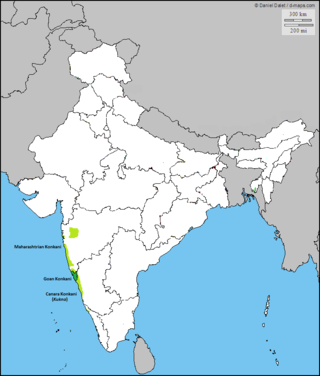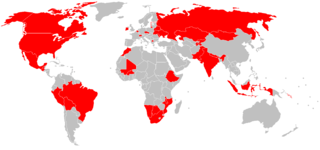
Marathi is an Indo-Aryan language predominantly spoken by Marathi people in the Indian state of Maharashtra. It is the official language of Maharashtra, and additional official language in the state of Goa. It is one of the 22 scheduled languages of India, with 83 million speakers as of 2011. Marathi ranks 11th in the list of languages with most native speakers in the world. Marathi has the third largest number of native speakers in India, after Hindi and Bengali. The language has some of the oldest literature of all modern Indian languages. The major dialects of Marathi are Standard Marathi and the Varhadi dialect.
This article concerns the demography of Réunion. People of Réunion are Réunionese. The official language is French, and Réunionese Creole is widely spoken. The population of Réunion is 966,129 as of 2021.

The United States does not have an official language at the federal level, but the most commonly used language is English, which is the de facto national language. It is also the language spoken at home by the great majority of the U.S. population. Many other languages are also spoken at home, especially Spanish, according to the American Community Survey (ACS) of the U.S. Census Bureau; these include indigenous languages and languages brought to the U.S. by people from Europe, Africa, and Asia. However, the majority of speakers of these languages are bilingual and also speak English. Although 21.5% of U.S. residents report that they speak a language other than English at home, only 8.2% speak English less than "very well." Several other languages, notably creoles and sign languages, have developed in the United States. Approximately 430 languages are spoken or signed by the population, of which 177 are indigenous to the area. At least fifty-two languages formerly spoken in the country's territory are now extinct.

Gujarati is an Indo-Aryan language native to the Indian state of Gujarat and spoken predominantly by the Gujarati people. Gujarati is descended from Old Gujarati. In India, it is one of the 22 scheduled languages of the Union. It is also the official language in the state of Gujarat, as well as an official language in the union territory of Dadra and Nagar Haveli and Daman and Diu. As of 2011, Gujarati is the 6th most widely spoken language in India by number of native speakers, spoken by 55.5 million speakers which amounts to about 4.5% of the total Indian population. It is the 26th most widely spoken language in the world by number of native speakers as of 2007.

A wide variety of languages are spoken throughout Asia, comprising different language families and some unrelated isolates. The major language families include Austroasiatic, Austronesian, Caucasian, Dravidian, Indo-European, Afroasiatic, Turkic, Sino-Tibetan and Kra–Dai. Most, but not all, have a long history as a written language.

Languages spoken in India belong to several language families, the major ones being the Indo-European languages spoken by 78.05% of Indians and the Dravidian languages spoken by 19.64% of Indians, both families together are sometimes known as Indic languages. Languages spoken by the remaining 2.31% of the population belong to the Austroasiatic, Sino–Tibetan, Tai–Kadai and a few other minor language families and isolates. As per the People's Linguistic Survey of India, India has the second highest number of languages (780), after Papua New Guinea (840). Ethnologue lists a lower number of 456.

The American Community Survey (ACS) is a demographics survey program conducted by the U.S. Census Bureau. It regularly gathers information previously contained only in the long form of the decennial census, such as ancestry, citizenship, educational attainment, income, language proficiency, migration, disability, employment, and housing characteristics. These data are used by many public-sector, private-sector, and not-for-profit stakeholders to allocate funding, track shifting demographics, plan for emergencies, and learn about local communities. Sent to approximately 295,000 addresses monthly, it is the largest household survey that the Census Bureau administers.
Bombay Hindi, also known as Bambaiya Hindi or Mumbaiya Hindi, is the Hindi dialect spoken in Mumbai (Bombay), in the Konkan region of India. Its vocabulary is largely from Hindustani, additionally, it has the predominant substratum of Marathi-Konkani, which is the official language and is also widely spoken in the Konkan division of Maharashtra. Bombay Hindi also has elements of Gujarati.

Konkani is an Indo-Aryan language spoken by the Konkani people, primarily in the Konkan region, along the western coast of India. It is one of the 22 scheduled languages mentioned in the Indian Constitution, and the official language of the Indian state of Goa. It is a minority language in Karnataka, Maharashtra, Kerala, Gujarat & Damaon, Diu & Silvassa.

Saurashtra is an Indo-Aryan language spoken primarily by the Saurashtrians of Southern India who migrated from the Lata region of present-day Gujarat to south of Vindhyas in the Middle Ages.

Varieties of the French language are spoken in France and around the world. The Francophones of France generally use Metropolitan French although some also use regional dialects or varieties such as Meridional French. In Europe outside France there are Belgian French, Swiss French, and in Italy Aostan French. In Canada, French is an official language along with English; the two main dialects of French in Canada are Quebec French and Acadian French. Standard French is also commonly grouped as Canadian French. In Lebanon, French was an official language until 1941 and the main dialect spoken there is Lebanese French or Levantine French. Levantine French was also spoken by Sephardic Jews in Salonica, Istanbul and Smyrna, by Armenians and Greek bourgeois in the urban centres of Asia Minor, by Syrian Catholics and Melkites in Aleppo and Beirut.
The voiced retroflex lateral flap is a type of consonantal sound, used in some spoken languages. The expected symbol in the International Phonetic Alphabet is ⟨𝼈 ⟩. The sound may also be transcribed as a short ⟨ɭ̆ ⟩, or with the old dot diacritic, ⟨ɺ̣⟩.

Western India is a loosely defined region of India consisting of its western part. The Ministry of Home Affairs in its Western Zonal Council Administrative division includes the states of Goa, Gujarat, and Maharashtra along with the Union territory of Dadra and Nagar Haveli and Daman and Diu, while the Ministry of Culture and some historians also include the state of Rajasthan. The Geological Survey of India includes Maharashtra but excludes Rajasthan whereas Ministry of Minority Affairs includes Karnataka but excludes Rajasthan.

Since the Iron Age in India, the native languages of the Indian subcontinent are divided into various language families, of which the Indo-Aryan and the Dravidian are the most widely spoken. There are also many languages belonging to unrelated language families such as Austroasiatic and Sino-Tibetan, spoken by smaller groups.
The languages of North America reflect not only that continent's indigenous peoples, but the European colonization as well. The most widely spoken languages in North America are English, Spanish, and to a lesser extent French, and especially in the Caribbean, creole languages lexified by them.
The phoneme inventory of the Marathi language is similar to that of many other Indo-Aryan languages. An IPA chart of all contrastive sounds in Marathi is provided below.

South Asia is home to several hundred languages, spanning the countries of Afghanistan, Bangladesh, Bhutan, India, Nepal, Pakistan, Maldives and Sri Lanka. It is home to the third most spoken language in the world, Hindi–Urdu; and the sixth most spoken language, Bengali. The languages in the region mostly comprise Indo-Iranic and Dravidian languages, and further members of other language families like Austroasiatic, Turkic, and Tibeto-Burman languages.
Tamil Nadu is one of the 28 states of India. Its capital and largest city is Chennai. Tamil Nadu lies in the southernmost part of the Indian Peninsula and is bordered by the States of Puducherry, Kerala, Karnataka and Andhra Pradesh. It is the tenth-largest state in India and the seventh most populous state.

Many countries and national censuses currently enumerate or have previously enumerated their populations by languages, native language, home language, level of knowing language or a combination of these characteristics.











